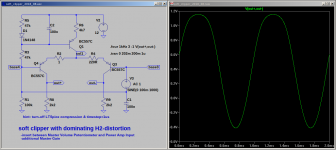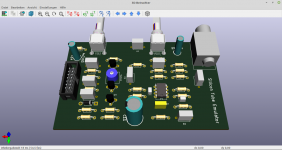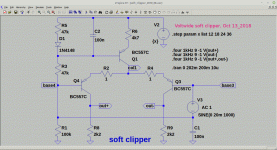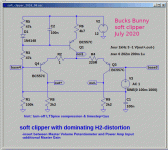I propose a simple differential BJT amplifier as a soft peak limiter combined with additional asymmetric H2 distortion that is generally attributed to tube sound.
The symmetrical output drives directly the inputs of TPA3255, for instance. Setup properly, PBTL-output level is limited below the class-D typic clipping.
The LTSpice simulation shows the contribution of the emitter resistor to H2 and may intrigue you to play around with different values.
Enjoy
The symmetrical output drives directly the inputs of TPA3255, for instance. Setup properly, PBTL-output level is limited below the class-D typic clipping.
The LTSpice simulation shows the contribution of the emitter resistor to H2 and may intrigue you to play around with different values.
Enjoy
Attachments
Member
Joined 2009
Paid Member
What exactly is clean? The THD rises smoothly with level, this is the nature of a soft clipper contrary to the ultra low THD over a wide range with hifi amps that clip hard. You cannot get both at the same time - and so it is a matter of personal taste to balance the clean range versus soft clipping.
The asymmetric H2 distortion rises with level as well. But in the clipping region symmetric distortion dominates. There is nothing I can do about that.
Asymmetric full clipping may be achieved with so called "blocking distortion" - a very poor feature of the old days imho.
Feel free to check the simulation at different input levels and different emitter resistor. This may open your eyes.
The asymmetric H2 distortion rises with level as well. But in the clipping region symmetric distortion dominates. There is nothing I can do about that.
Asymmetric full clipping may be achieved with so called "blocking distortion" - a very poor feature of the old days imho.
Feel free to check the simulation at different input levels and different emitter resistor. This may open your eyes.
Last edited:
In the Musical Instrument world at least, "clean" is anything which is not harsh flat top (and bottom) clipping.
Such as "Fender clean"
Smoothly rounded and gently twisting waveforms , as well *** assymetry are welcome
Intermodulation is also welcome, it´s perceived as adding "warmth" and "character".
Both subjective terms, of course, but Musicians understand them very well.
Such as "Fender clean"
Smoothly rounded and gently twisting waveforms , as well *** assymetry are welcome
Intermodulation is also welcome, it´s perceived as adding "warmth" and "character".
Both subjective terms, of course, but Musicians understand them very well.
No.does it play clean, without IMD, below clipping ?
Any lack of linearity WILL create intermodulation, as soon as you inject 2 or more different frequencies.
But intermodulation is far more acceptable and less noticed than plain clipping.
Painting with a broad brush, SS amps (and preamps) are either VERY clean or sharp distorted, Tube ones offer a lot of smoother intermodulation before clipping.
Last edited:
I know, my question just referred to a soft limiter without IM. A no go that you have explained meanwhile.In the Musical Instrument world at least, "clean" is anything which is not harsh flat top (and bottom) clipping.
Such as "Fender clean"
Smoothly rounded and gently twisting waveforms , as well *** assymetry are welcome
Intermodulation is also welcome, it´s perceived as adding "warmth" and "character".
Both subjective terms, of course, but Musicians understand them very well.
Last edited:
Btw, this is an old idea of mine dating back to the 70s or 80s. At that time I discovered in an RCA data book CA3080 where the scope plot of the s-shaped transfer function had been depicted. It made "click" and immediately I saw the solution for a smooth distorting unit better than si-diodes or ge-diodes. I used these transconductional operational amplifiers (OTAs) over decades until they went obsolete. Breaking down its intrinsic circuitry it is just a differential amplifier feeding current mirrors that can be emulated with few discrete off-the-shelf components.
And as a benefit the access to emitter degeneration adds the option of asymmetric distortion.
And as a benefit the access to emitter degeneration adds the option of asymmetric distortion.
For all those who want to verify the solid-state tube emulator I designed a quick and dirty evaluation pcb. This board is single-sided 70 by 110mm with tht parts only. Resistors pitch is 10mm, pitch5/10mm combo layout for film caps, track width is 0.8mm. The potentiometers I used are ALPS RK09L tandem, the TRS jacks NRJ6HF from Neutrik. All in all no fine-pitch, should by doable with home etching.
Attachments
Last edited:
Some hints:
Now there is a trimpot to adjust symmetry. In the middle position it should be symmetric.
I added a 1knob-equalizer and input buffer with hi-z-input thus this module may serve as a basis guitar pre-amp stage.
The 14-pin IDC socket connects DC-power and symmetric output. A ribbon cable with open wire ends provides removable and yet DIY-friendly access.
Now there is a trimpot to adjust symmetry. In the middle position it should be symmetric.
I added a 1knob-equalizer and input buffer with hi-z-input thus this module may serve as a basis guitar pre-amp stage.
The 14-pin IDC socket connects DC-power and symmetric output. A ribbon cable with open wire ends provides removable and yet DIY-friendly access.
Some hints:
Now there is a trimpot to adjust symmetry. In the middle position it should be symmetric.
I added a 1knob-equalizer and input buffer with hi-z-input thus this module may serve as a basis guitar pre-amp stage.
The 14-pin IDC socket connects DC-power and symmetric output. A ribbon cable with open wire ends provides removable and yet DIY-friendly access.
Now there is a trimpot to adjust symmetry. In the middle position it should be symmetric.
I added a 1knob-equalizer and input buffer with hi-z-input thus this module may serve as a basis guitar pre-amp stage.
The 14-pin IDC socket connects DC-power and symmetric output. A ribbon cable with open wire ends provides removable and yet DIY-friendly access.
hum, for us elderly is seems inavoidable to talk twice
hum, for us elderly is seems inavoidable to talk twice
...CA3080 where the scope plot of the s-shaped transfer function .... decades until they went obsolete....
The '3080 is available today. Yes, it was discontinued and then fakes flooded the market. But Steve "Small Bear" and Rochester got a mask and ran a wafer.
Rochester Electronics (en-US) : Search for 3080
Small Bear Electronics - Search Results for "3080"
Small Bear is a very small operation in a dense city and was Corona-closed for months. They seem to be shipping again but warn of long times.
Rochester seems to be working split-shift and moving product, but has large minimum orders.
Huh. Another diyAudio member (whose username was first "Voltwide", and later changed to "29285" before he requested his account be disabled, and quit diyAudio altogether) had exactly the same idea, and used it in several of his solid-state guitar amps; post #10 in this thread from 2018 is one example: https://www.diyaudio.com/forums/instruments-and-amps/328573-tramp-guitar-amp.html#post5572373Btw, this is an old idea of mine dating back to the 70s or 80s. At that time I discovered in an RCA data book CA3080 where the scope plot of the s-shaped transfer function had been depicted.
Voltwide, being a sharing and generous man, also posted the LTSpice simulation file (the .asc file), in the same post; he thus made it trivially easy for anyone to open up his simulation in LTSpice.
What I don't understand is the astronomically improbable coincidence that Voltwide's 2018 circuit (featured in this thread) is virtually identical to Bucks Bunny's July 2020 circuit. Every component value, every component label, even the names given to circuit nodes (like Base3 and Base4) is identical - except R4 has been increased from 1 ohm to 220 ohms, and V2 is set at 12 volts instead of stepping through four different values.
I'm attaching both schematics, for easy comparison.
I feel like a character in a Hercule Poirot novel; is Bucks Bunny the same person as Voltwide, aka 29285, or are we looking at a case of blatant plagiarism?
I hope I haven't accidentally "outed" someone in a European equivalent to the American Federal Witness Protection Program.
-Gnobuddy
Attachments
- Home
- Live Sound
- Instruments and Amps
- A "tubey" solid-state soft limiter



